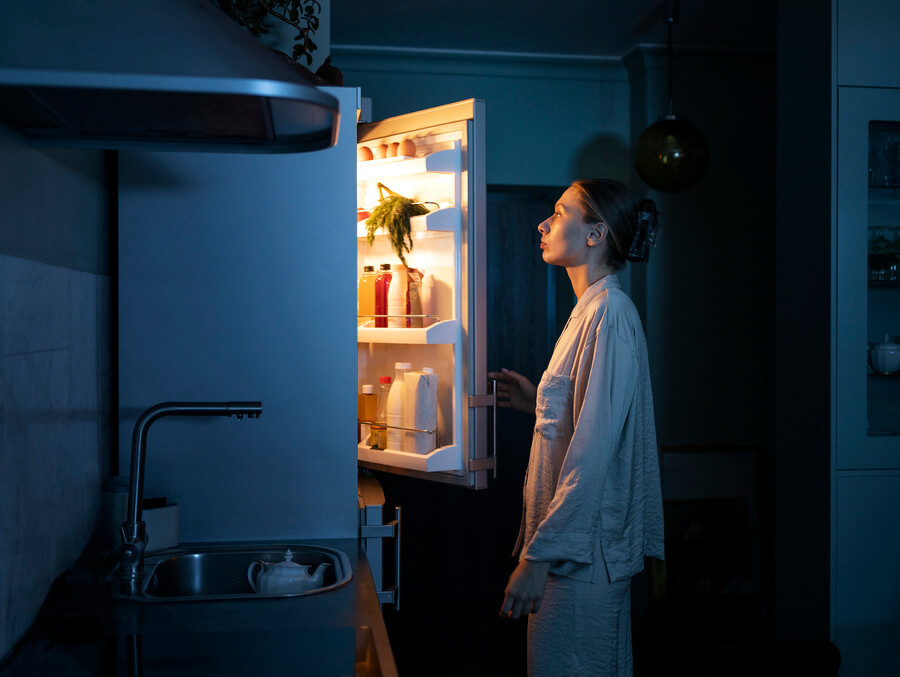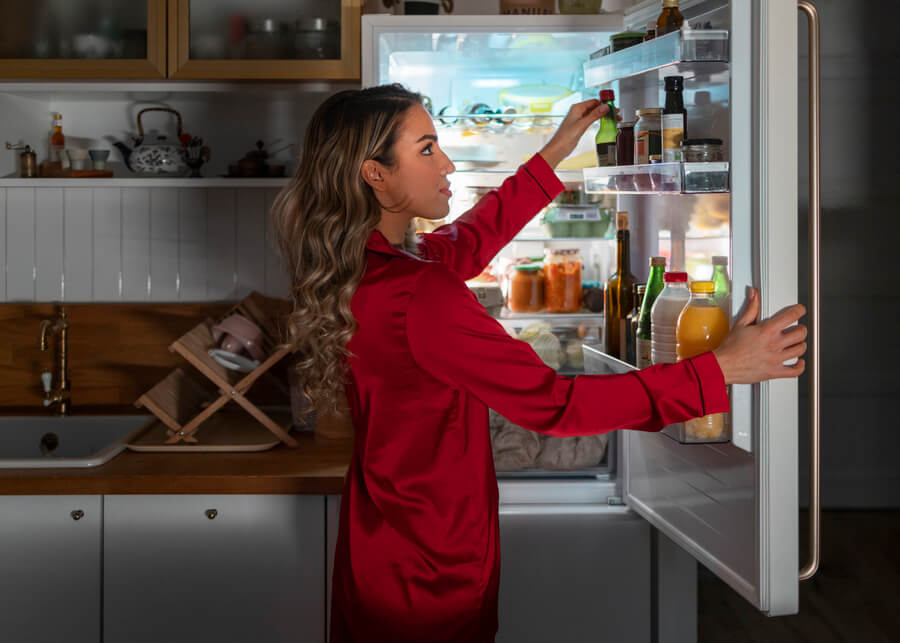Your refrigerator is more than just an appliance; it’s a lifeline for your food, energy bills, and the environment. Imagine you’ve just closed your refrigerator door, expecting the cooling system’s comforting hum and the subtle click of the light turning off.

Yet, to your surprise, the light inside stubbornly continues to glow, wasting energy and potentially causing your groceries to spoil faster. A refrigerator light staying on when the door is closed can be annoying and indicate an underlying issue needing immediate attention.
In this comprehensive guide, we’re here to illuminate the problem and provide practical solutions to fix it. Understanding why its light misbehaves and learning how to rectify the situation can save you both frustration and money in the long run. Let’s dive in.
Check for Obstructions
Starting with the basics is essential when your refrigerator light stays on even with the door closed. Check for any obstructions that might be preventing the door from closing fully.
Sometimes, items stored in the fridge can shift, or containers might be placed in a way that interferes with the door’s proper closure.
Make sure there are no protruding food items or containers that are blocking the door’s path. Push or rearrange things to ensure a precise, unobstructed door closure.
Clean the Door Seal
A common reason for the refrigerator light to stay on when the door is closed is the presence of debris or food particles on the door seal or gasket. Over time, these particles can accumulate and prevent the seal from adequately contacting the refrigerator’s frame.
To fix this issue, start by unplugging or turning off the fridge for safety. Then, use a mixture of warm, soapy water and a soft cloth or sponge to clean the door seal thoroughly.
Pay close attention to crevices or folds where debris might hide in the seal. Rinse clean water and dry it thoroughly before plugging the refrigerator back in.
This simple cleaning routine often resolves the problem by allowing the seal to create an airtight closure when the door is shut, ensuring the light turns off as intended.

Inspect the Gasket
Carefully examine the door gasket or rubber seal for any visible signs of wear, cracks, or damage. Even small tears or deformities can disrupt the seal, causing the light to stay on.
If you identify any issues with the gasket, it’s advisable to replace it. Replacement gaskets are often available from refrigerator manufacturers or appliance parts stores.
Replacing a damaged gasket can effectively resolve the problem of the light staying on and improve the overall efficiency of your refrigerator.
Adjust the Door Hinges
Misaligned doors can commonly cause the refrigerator light to stay on when the door is closed. To address this issue, locate the hinge screws on the refrigerator door and gently loosen them with the help of a wrench or screwdriver.
Carefully reposition the door to align correctly with the frame and form a tight seal. Once adjusted, tighten the screws back in place. Refer to your refrigerator’s user manual for specific guidance on hinge adjustment.
Proper alignment ensures the door pressurizes the switch correctly, turning off the light when the door is closed.
Check the Door Switch
The door switch controls the refrigerator light. It’s typically a tiny button or lever near the door frame’s edge. When the door is closed, it should depress the switch, cutting power to the light.
If the switch is damaged, stuck, or malfunctioning, it won’t function correctly. To test the switch, press it manually with your finger to see if it activates and deactivates the light.
If it doesn’t, you may need to replace the door switch. Refer to your refrigerator’s manual or seek guidance from the manufacturer on obtaining a compatible replacement switch and instructions for installation.
Replacing a faulty door switch can often resolve the issue of the light staying on when the door is closed, restoring the proper functioning of your refrigerator.
Check the Light Bulb
Sometimes, a malfunctioning light bulb can be why the refrigerator light stays on when the door is closed. To troubleshoot this, turn off the refrigerator and unscrew the light bulb.
If the bulb continues to glow even when removed from the socket, it’s likely defective and needs replacement. Ensure you replace it with a bulb matching the wattage and type recommended in your refrigerator’s manual.

Check the Wiring
If none of the previous solutions resolve the issue, there could be a problem with the wiring connecting the light to the switch and the power source.
This can result from loose connections, frayed wires, or short circuits. However, electrical repairs can be dangerous if you’re not experienced, so it’s essential to avoid attempting this yourself.
Instead, contact a qualified appliance technician to inspect and repair the wiring. They will have the necessary skills and tools to diagnose and resolve wiring issues safely.
Check the Timer
Some refrigerators feature timers that control when the interior light turns on or off according to a predefined schedule. For example, specific models have a night mode that conserves energy by turning off the light during particular hours.
If your refrigerator has a timer, inspect its settings to ensure it’s functioning correctly. You can adjust the timer to suit your preferences or turn it off entirely if you prefer manual control over the light.
Check for Power Surges
Electrical power surges can cause damage to appliances and disrupt their regular operation, including keeping the light on when it should be off. If your refrigerator has been exposed to a power surge, it may affect its performance.
Consider using a surge protector or an uninterruptible power supply (UPS) to safeguard your fridge from future surges. Additionally, you can attempt to reset your refrigerator by unplugging it from the power source for a few minutes and then plugging it back in.
This simple reset may resolve any temporary issues caused by power fluctuations. If the problem persists, consult a technician to assess and address any damage from power surges.
Check for Frost Buildup
Frost buildup inside the freezer compartment can lead to various issues, including the refrigerator light staying on. Excess frost can obstruct the light switch or sensor, preventing them from correctly detecting when the door is closed.
Additionally, it can hinder the fridge’s cooling system, causing it to run longer than necessary. To address this, regularly defrost your freezer as your refrigerator’s manual recommends. This will help prevent frost buildup and maintain proper airflow and temperature inside the appliance.
Check for Humidity Issues
High humidity levels in your kitchen can affect your refrigerator’s performance and efficiency. Excessive humidity can make the fridge work harder to maintain its temperature, leading to prolonged light operation.
It can also create condensation, mold, or mildew inside the refrigerator, potentially damaging food and the appliance. To reduce humidity, position your refrigerator away from heat sources like ovens or dishwashers and ensure proper kitchen ventilation.
You can also use a dehumidifier in your kitchen to manage humidity levels effectively.
Check for Faulty Sensors
Some refrigerators have sensors that detect when the door is open or closed, automatically adjusting the light accordingly. If these sensors malfunction, they may fail to register when the door closes, causing the light to remain on.
To test these sensors, open and close the refrigerator door several times, observing their response. If they do not respond correctly, you may need to replace or recalibrate them.
Refer to your refrigerator’s manual for sensor replacement or recalibration guidance, or consult a technician for necessary assistance. Correcting faulty sensors will help ensure the light operates as intended when the door is closed.
Conclusion
In conclusion, a refrigerator light that stays on when the door is closed can cause several problems, such as increasing energy consumption, spoiling the food, and damaging the bulb.
To fix this issue, you can try the listed simple solutions; following these steps can fix the problem and save energy and money in the long run. However, if none of these work, you may need to contact a professional technician for further assistance.
